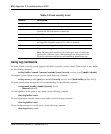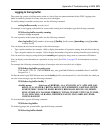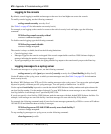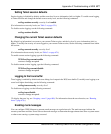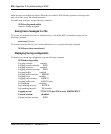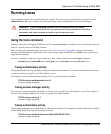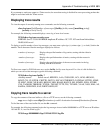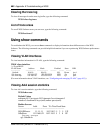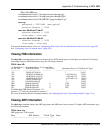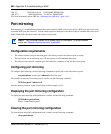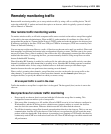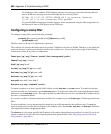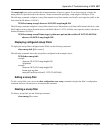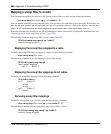
Appendix A:Troubleshooting a WSS 681
Nortel WLAN—Security Switch 2300 Series Configuration Guide
If you attempt to send trace output to a Telnet session, be aware that tracing is disabled for areas processing packets that
might be associated with the Telnet session.
Displaying trace results
To view the output of currently running trace commands, use the following command:
show log trace [{+|-|/}number-of-messages] [facility facility-name] [matching string]
[severity severity-level]
For example, the following command displays a trace log of error-level events:
WSS# show log trace severity error
KERNEL Jan 15 23:08:10 ERROR duplicate IP address 10.7.122.102 sent from link address
00:05:5d:45:ae:cd
To display a specific number of trace log messages, you must enter a plus sign (+), minus sign (-), or slash (/) before the
number. These characters filter the messages displayed as follows:
To filter trace output by WSS Software area, use the facility facility-name keyword. For a list of valid facilities for
which you can view event messages, type the following command:
WSS# show log trace facility ?
<facility name> Select one of: KERNEL, AAA, SYSLOGD, ACL, APM, ARP,ASO,
BOOT, CLI, CLUSTER, CRYPTO, DOT1X, ENCAP, ETHERNET, GATEWAY, HTTPD, IGMP,
IP, MISC, NOSE, NP, RAND, RESOLV, RIB, ROAM, ROGUE, SM, SNMPD, SPAN, STORE,
SYS, TAGMGR, TBRIDGE, TCPSSL, TELNET, TFTP, TLS, TUNNEL, VLAN, X509, XML, AP,
RAPDA, WEBVIEW, EAP, PORTCONFIG, FP.
Copying trace results to a server
To copy the contents of the trace buffer to a file on a TFTP server, use the following command:
copy trace-buffer-name tftp://[destination-ip-addr | destination-hostname]/destination-filename
To find the name of the trace buffer file, use the dir command.
For example, the following command copies the log messages in trace buffer 0000000001 to a TFTP server at IP address
192.168.253.11, in a file called log-file:
WSS# copy 0000000001 tftp://192.168.253.11/log-file
+number-of-messages Displays the specified number of log entries, starting with the oldest in
the log.
-number-of-messages Displays the specified number of entries, starting with the newest in
the log.
/number-of-messages Displays the specified number of the most recent entries in the log,
starting with the least recent.




